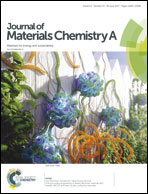Biomass to porous carbon in one step: directly activated biomass for high performance CO2 storage†
Abstract
This report explores the direct conversion of biomass to activated carbons in one step. We demonstrate the successful conversion of a range of biomass sources, namely, sawdust, the flowering plant Paeonia lactiflora and seaweed (Sargassum fusiforme), to activated carbons via a direct activation process that negates the need for hydrothermal carbonisation or pyrolysis. This is a departure from established practice that requires biomass sources to be first enriched to carbonaceous matter via hydrothermal carbonisation or pyrolysis prior to activation. The direct activation, with KOH as an activating agent, generated activated carbons at yields that are comparable or higher than those of conventional activation routes. The directly activated carbons, whilst offering the advantages of simplicity, lower cost and a greener more sustainable synthesis route, have properties that are similar or superior to analogous carbons prepared via conventional methods. In particular the textural properties, surface functionality and level of graphitic ordering were found to be similar to those of conventionally generated activated carbons. Depending on the activation conditions, the porosity of the directly activated carbons may be tailored towards pore channels of size 5–7 Å, which favour post-combustion CO2 uptake and thus the carbons capture up to 1.3 and 4.6 mmol g−1 of CO2 at 0.15 and 1 bar, respectively, and 25 °C with high selectivity. On the other hand, at higher levels of activation, the directly activated carbons can be tailored towards possessing a greater proportion of larger micropores (10–20 Å pores) and small mesopores (20–30 Å pores) so as to optimize CO2 uptake at moderate to high pressure, for example up to 22 mmol g−1 (at 25 °C) and 31 mmol g−1 (at 0 °C) at 20 bar.



 Please wait while we load your content...
Please wait while we load your content...